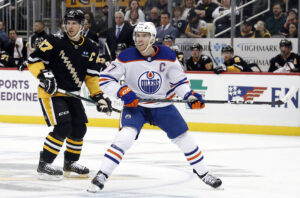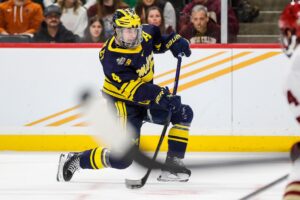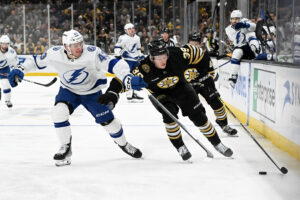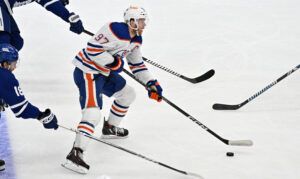Carey Price has received a bad-rap from the hockey world. As the 2019-20 season came to its premature close, many were calling the goalie out as a weakness in the Montreal Canadiens system. He was accused of complacency in his older age, with many claiming he was one of the issues holding Montreal back this season. To justify these bashes of the former-Vezina winner, many turned to statistics. Price set his second-lowest save percentage in the last 10 years and had seemingly-cloudy advanced stats, things critics were quick to point out.
But there’s a glaring issue with using statistics to attack Carey Price. While they may seem solid, goalies are really, really hard to track. There’s no golden stat for every goalie and each analyst, statistician, and website has their own ways of breaking things down; ways that always seem to be missing key elements.
Peeling the layers back shows a completely different picture, though. While, as mentioned, there’s no perfect model to objectively look at goalies, the best available options argue a surprising take: Carey Price’s 2019-20 performance was far from poor. In fact, he was among the league’s best this year.
Carey Price’s 2019-20 Season was Terrific
The Issue
Tracking a player is easy. Well, relatively speaking. It’s easy for a hyper-trained eye to keep tabs on when a player shoots, where he shoots from, and to use mathematical systems to apply things like shot quality to those shots. This is why stats like xGF/60 and xGA/60 (expected-goals-(for/against) per-60) have become such tremendous markers of offensive and defensive talent. While they’re not tell-alls, they provide one of the best objective looks into how a team performs with any given player on the ice. Further breaking down of these stats, like with RAPM or GAR, give an even better dive into the incredible break down that the numbers provide.
It’s not that easy with goalies. Not at all. First off, goalies require tons of sample to get any sort of accurate picture. The twins that run Evolving Hockey, one of the top stat-sites in the hockey world, summed this up really well. They said, “goalies demonstrate an extreme amount of variability, so we generally need a ton of data (ie shots) to start to separate out skill [but] even when goalies have gotten to that point, they often are getting older, so age starts to then impact their overall ability.”
But even then, there are… a lot of issues with narrowing down reliable stats. Evolving Hockey went further, adding, “I think with more ‘granular’ data we might be able to identify skills/value that a goalie can provide that we do not currently have access to. Like positioning, glove position, rebounds. And then obviously skater position in front, etc… It’s really just a big mess.”
Evolving Hockey made sure to add that stats like xG (expected-goals) can help muddle through some fog involved with rebounds but there are still plenty of rebound-related issues apparent, even with the added help. They also noted that they, “know a few proprietary places have quite different goalie results,” but aren’t fortunate enough to be able to see into the secrets.
An Uphill Battle
As Evolving Hockey summed up, there’s… issues. The intricacy of goaltending creates a challenge for statisticians, particularly looking at how they attack the issue of rebounds. It’s a very important decision to make as well. Goaltenders who allow plenty of rebounds could be at an advantage in a raw system, over a goalie who doesn’t allow as many. Because of this, deciding how to filter rebounds can result in drastic changes from site-to-site. Places like Evolving Hockey have chosen to forgo filtering out what are known as “rebounds-above-expected”, a tactic that is used by sites like CrowdScoutSports. Other sites, like MoneyPuck, add in what’s known as a ‘flurry-adjuster’ to account for rebounds.
There are other issues apparent, like arena bias. With stats still being manually-tracked by the league, there can be a definite sway from rink-to-rink. JFresh touches on this well in a recent article of his own. In short, MoneyPuck and CrowdScout have tools to adjust for this bias. Evolving Hockey does not.
What This Means for Carey Price
His Sample Size
Carey Price tops out as one of the harder goalies to track, in an already difficult group. He ranked second in shots-against and fenwick-against this season, just narrowly falling under Connor Hellebuyck‘s first-place spot in both categories. This means that, while his sample size was larger and thus a bit easier to frame, he was also subject to a lot of work.
Price’s sample also can not be cut down by adjusting for rebounds either. According to one of CrowdScout’s many, many charts, Price was actually above-average in controlling rebounds. Hellebuyck, on the other hand, was below-average in the category. This means that, ultimately, Price had the largest rebound-adjusted sample size in the entire league.
Expected-Goals-Against (xGA)
The downsides don’t end there for Price. Not only did he have the largest sample size, but he also had the second-highest xGA of any goalie. Only Hellebuyck’s xGA was higher. This stat does exactly what it says on the tin: finding how many goals a goalie would be expected to give up based on the quality of shots they faced. Price’s incredibly high tally shows how awful of a job the Habs defence did at limiting their opposition’s scoring chances. Price was placed in a situation reminiscent of Hellebuyck, who played behind a league-worst defence, and was also in a worse situation than John Gibson, Sergei Bobrovsky, Jonathan Bernier, and plenty of other goalies that played for much worse teams than Montreal.
Price was left to fend for himself this season, to say the least. His league-high sample size and second-highest xGA will also noticeably skew his advanced stats.
The Better Save Percentage
The lesser of the two go-to advanced stats that are best for analyzing goalies are the variations on save percentage. There are many different versions but the most common tend to look at the difference between the goalie’s expected-save-percentage, based on their xGA, versus their actual save percentage.
This is the statistic that Carey Price flounders most in. In Evolving Hockey’s unfiltered model, Price’s dFSv% ranks 50th among all goalies and 23rd among the league’s 31 starters. In MoneyPuck’s flurry-adjusted model, Price ranked 18th among starters; a bit better but still disconcerting.
And while these stats do have merit, they can’t be taken at face value for Price. These stats fail to take into account every woe Price faced. His monster-high xGA significantly skews his dFSv%, as it sets a fairly high bar. While not unreachable, a goalie needs to perform at a Vezina-winning-rate in the likes of Hellebuyck’s this season to even come close.
Goals Saved Above Expected/Average
There are plenty of other slight woes that keep dFSv% from perfectly applying to Price’s situation. What’s better used are GSAA (goals-saved-above-average) and GSAx (goals-saved-above-expected) which look at a goalie’s actual saved-goals, instead of basing their stats off of the number of shots they faced, ultimately. Of course, it’s more intimate than this, but ultimately these fit much better for a goalie that faces high-volume, high-danger shots like Price.
GSAA and GSAx are more stats that many sites have their own versions of but among the best are the numbers on CrowdScoutSports, who fully adjust for rebounds and arena bias. CrowdScoutSports doesn’t provide raw data but they do have over 30 great models showcasing a variety of stats, ranking goalies appropriately. The two-best among these models looks at goalies’ GSAx and GSAA:
GSAx Chart
https://imgur.com/a/LQwnED0
This graph shows… a lot. With every goalie ranked, it can be hard to decipher through the clutter. Luckily, Price’s obscene shots-faced have him ranked in a world of his own, where it’s very clear that he outperformed what an “average” goalie would’ve done (represented by the black trendline). In fact, Carey Price’s deviation from the trendline was among the best of any goalie in the league. It doesn’t place him in a Vezina-worthy category but he is clearly worth a top-10 ranking by this chart. This same sentiment is argued by his GSAA chart:
GSAA Chart
Price’s GSAA speaks the same sentiment. Adjusting for rebounds, Price again had one of the absolute best tallies of any goalie in the league. Looking specifically at the Eastern Conference, the only goalies to outperform (shown by higher ranking on the Y-Axis) Price were Tuukka Rask, Andrei Vasilevsky, Frederik Andersen, and Mackenzie Blackwood. Including the Western Conference, only Connor Hellebuyck and Ben Bishop ranked better than Price. This effectively places Price as the seventh-best goalie in the league; something that is vouched for by the GSAx model as well.
Plenty More
There’s much, much more arguing that Price’s 2019-20 season was top-end. Price managed to rank seventh among goalies by the most applicable, best-adjusted stats despite the fact that he faced the second-toughest situation of any goalie in the league in terms of both non-rebound shots and shot quality, only behind soon-to-be Vezina-winner Connor Hellebuyck.
In fact, CrowdScoutSports also provides a terrific model that charts goals-saved-above-replacement (GSAR) against each goalie’s cap hit. And despite Price’s monstrous $10.5 million cap hit, CrowdScout’s model actually argues that it’s a fair contract. While not a steal, Price is playing perfectly in-line with his daunting cap hit.
In the End
Price’s save percentage-based stats weren’t jaw-dropping but relying solely on them doesn’t work in Price’s unique situation. Some site’s numbers also can’t be entirely leaned on for analyzing Price, who ranked in the top-three of the NHL’s starters in rebound control; something that should be praised, not harm his stats.
The stats that do adjust for Carey Price’s rebounds and shot-volume-faced argue one clear thing: Price is a top-10 goalie. The Canadiens skaters forced Price into a corner and, despite that, the veteran goalie did an incredible job of remaining one of the best goalies in the league.
There is simply no reason to speak down Price’s 2019-20 season. He was one of the best in the league, well-deserving of his cap hit and one of the brightest spots on a Canadiens lineup that had its fair share of ups-and-downs. Price’s phenomenal Qualifying Round didn’t come out of nowhere. His elite ability just finally showed through once his team started helping him out more.
Carey Price is still one of the best goalies in the league. There is simply no other statistically-based argument.
Huge thanks to Evolving Hockey (@EvolvingWild), JFresh (@JFresh), MoneyPuck (@MoneyPuckdotcom), and CrowdScoutSports (@Ice_Cole_Data). Their terrific models and help made this article a possibility.
Main Photo:






